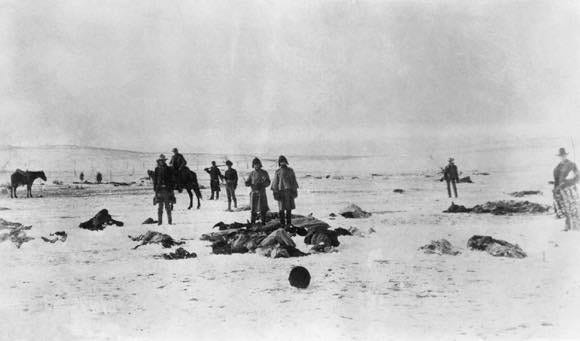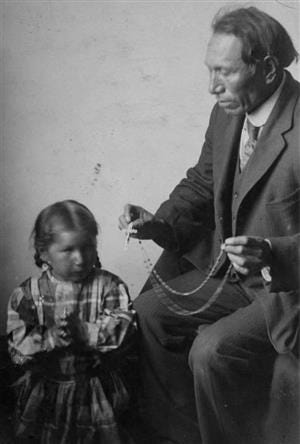What Profit Would There Be?
August 7th, 2025 The Memorial of Saint Dominic, Priest
The Jay Cooke & Company bank overinvested in the Northern Pacific Railroad Company, which defaulted on its loans in 1873, causing the bank to collapse, which simultaneously sent the United States into what at the time would be known as the Great Depression before the 1930s—otherwise known today as the Panic of 1873.
On an assignment in what is now South Dakota, George A. Custer’s expedition discovers gold in the Black Hills in 1874. In 1868, the United States government agreed to a treaty with the Sioux Nation to create a boundary known as the Great Sioux Reservation that included the Black Hills to be protected as Sioux lands, as outlined in the Fort Laramie Treaty. President Ulysses S. Grant, facing the new economic depression, with the United States Government, sent Custer’s 7th Cavalry into the Black Hills under the guise of protecting prospectors illegally entering the agreed Sioux Nation land. It’s important to note that in constitutional law, any treaty agreed upon by the United States becomes the law of the land.
The illegal entry into the Sioux Nation would lead to the Battle of Little Bighorn, where Custer attacked a large camp of Sioux people on the Little Bighorn River, an encampment filled with Sioux women and children. Servant of God Nicholas Black Elk was present at the Little Bighorn River as a child. In 1877, the United States government illegally annexed the Black Hills with an agreement of only 10 percent of Lakota males. The fact that 10 percent of males is important because the 1868 Fort Laramie Treaty stipulated that 3/4 of Lakota males must agree to any land transfers. In 1980, the Supreme Court of the United States ruled in favor of the Lakota that the Black Hills were illegally taken from them and awarded them $17 million with interest, for a total of $ 102 million that currently still sits in the U.S. Treasury.1
What happened to the Lakota between 1877 and 1980? Over three hundred were massacred at Wounded Knee Creek. United States policies separated children from parents to “kill the Indian, but save the man.” During World War II, the government came back to the reservations and told the Lakota in certain areas to leave their homes for practicing bombing raids. All for what? Gold? The use of more land? What was the price? The price was dignity and life.
In our gospel for today, Jesus says, "Whoever wishes to come after me must deny himself, take up his cross, and follow me. For whoever wishes to save his life will lose it, but whoever loses his life for my sake will find it. What profit would there be for one to gain the whole world and forfeit his life? Or what can one give in exchange for his life? For the Son of Man will come with his angels in his Father's glory, and then he will repay each according to his conduct. Amen, I say to you, there are some standing here who will not taste death until they see the Son of Man coming in his Kingdom."
The message is timeless—What profit would there be? I’ve been listening to the Little Wound School Lakota Oral History Project titled “Heart of All.” The twisted irony that I am confronted with is striking when speakers make the point that, in their view, the people who brought that timeless message of the gospel sought to profit at every turn and corner.
In the Meriam Report of 1928, as reported by the Heart of All Oral History Project, the report reads, “How many a missionary, when preaching the white man’s religion to the Indians, must be embarrassed by the thought of what the white race has done to the Indians.”2
I’ll admit reading Black Elk Speaks and historians like Oster, Steltenkamp, and Costello on the Lakota, the Oral History does get some facts wrong; however, the cultural memory is authentically actual—why should the Lakota people believe or trust those preaching the gospel?
I plan to write more on the topic of Black Elk and Lakota Catholicism, but I believe it is crucial to lend this perspective credibility. It isn’t easy because I am trying to be faithful to my Catholic faith. The challenge is to pick up my cross, learn the virtue of humility, and hopefully communicate the story of a Lakota man who, with his free agency, converted to the Catholic faith, believed in it.
I hope for the day Black Elk becomes a saint of the Catholic Church .
Jeffrey Ostler, The Lakota and the Black Hills: The Struggle for Sacred Ground (New York: Penguin, 2010), xvi.
Mark Hetzel, “Darkest Night : Pine Ridge to Bombing Range,” HEART OF ALL Oral History Project, December 4, 2022, https://www.heartofallohp.com/episodes/buffalo-nation-before-contact-64phz-4wd86.




God bless you or this article! The Church has made mistakes and yes sinned. When we do we must not only apologize, but seek the Holy Spirit's will as to how we must make up for the sins of our ancestors!!!!!